Insect & Disease Conditions Update
A printer-friendly version of this report is available on-line from the Conditions Report Index.
This
is the last edition of the Forest &
Shade Tree - Insect & Disease Conditions for Maine report for
2016. Although the leaves are falling
and the growing season is coming to a close, it is important to keep in mind some
fall tree care tips to ensure your trees overwinter in good health. For example, roots will continue to grow
until soil temperatures fall to a consistent 40° F. Thus, to encourage root
growth and prevent winter desiccation injury (especially winter burn in
conifers) fall watering is important.
Further, cleaning up leaf debris and pruning dead wood from trees
decreases overwintering spots for some diseases and insects that can harm trees
in spring. Wrapping the lower stem of high-value young and thin-barked trees
will discourage rodents from feeding on the bark and causing serious injury. Consider ways of protecting the regeneration
of desirable tree species in your wood lot so they escape deer browsing during
the winter months. Following these basics will help to ensure a positive start
to the 2017 growing season.
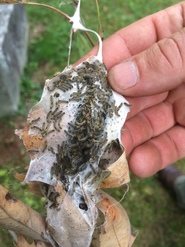
Over 63,000 acres of
forest in Sagadahoc County and surrounding towns were defoliated by the tiny,
early instar larvae of browntail moth (Euproctis
chrysorrhoea) in August and September. These larvae are less than ¼” in
length but are so numerous this year that in some cases they defoliated the same
trees twice in a single season. Those
trees were stripped in June, re-foliated with a stunted second flush of leaves
due to lack of water or still-feeding browntail caterpillars, and then
skeletonized in late-summer by the new generation of browntail. Add in the stress of the drought and the
trees were severely stressed this summer.
Photo: Browntail larvae preparing for winter (photo: Maine Forest Service).
In addition, browntail larvae and damage were found all the way south to
Eliot in York County and north to Waterville and Winslow in Kennebec
County. Moths were found in Millinocket
(Penobscot County), Monson (Piscataquis County) and Roque Bluffs (Washington
County) in July. This means people and deciduous trees (especially oak and
apple) across the southern half of the state could feel the effects of
browntail. Next year, outside the heavily infested area, this would most likely
be just spot infestations, a tree or a few trees.
|
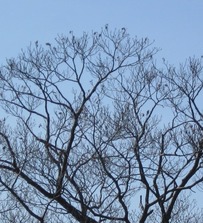
What to look for
this winter especially
in apple, crabapple, other fruit trees and oaks:
Browntail moth overwintering webs at the tips of branches. Silk wrapped around leaves and tied to branches (photo: Maine Forest Service).
Look on the TIPS of branches for leaves webbed together with bright
white silk into a very tight web usually 3–6 inches long. If you pull
the web apart there are dozens to hundreds of tiny caterpillars inside. (These
are not the filmy webs found on fruit trees, ash, maple and elm in late summer.
Those webs are made by the fall webworm and the larvae are gone by now.) If the
browntail moth overwintering webs are within reach then they can be cut out and
destroyed.
|
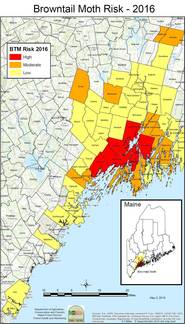 The Maine Forest Service will be conducting a winter web survey to get
a general overview of how far the browntail has spread and how intense it will
be. We welcome reports of browntail webs outside the area generally infested in
2016 (map left).
More detailed information can be found on our website.
|
 Balsam Woolly Adelgid (Adelges piceae)
–Balsam woolly adelgid (BWA) is an invasive insect that has been in North
America for decades. These adelgids attack only fir trees but their impact can
be serious. The tiny sucking insects feed either on the trunk (trunk phase) of
the trees and/or on the fast growing terminal shoots (gout phase). The
insertion of their mouthparts into the host tissue causes the tree to produce
abnormal cells in the current growth ring—with larger, resin-filled cells—that
are very poor at conducting water (an important normal function of that
tissue).
Photo: Balsam
woolly adelgid trunk phase (Photo: A. Wopat, Weyerhaeuser).
Heavy trunk populations can kill trees in two to
three years, while the shoot feeding causes “gouting” or swelling of the twigs
that stunts branch growth and the trees decline slowly over a number of years.
The population has been low for the past ten years but
recent warmer winter temperatures may be allowing it to resurge. The dry
conditions this spring and summer will exacerbate impact from this pest. The trunk phase has been reported from a
number of locations in Franklin, Kennebec, Oxford, Penobscot, Piscataquis and
Washington Counties.
|
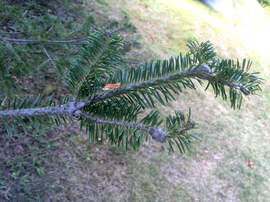 Landowners with fir and
Christmas tree growers should take some time to inspect their trees for BWA. Targeted
removal of trees with moderate to heavy trunk phase will reduce BWA populations
in forest stands. Growers seeing BWA damage on Christmas tree crop may want to
remove infested fir from surrounding woodlands to lessen the impact on production
trees.
Photo: Balsam
woolly adelgid gout phase (Photo: Maine Forest Service).
|
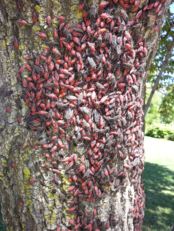 Boxelder Bug
(Boisea trivitatta) – The boxelder bug is a species of true bug that feeds
primarily on the seeds of boxelder and other maple species. It is not considered a pest of trees, but in these
cooler days of early autumn, huge congregations of the bugs may gather in sunny
areas prior to seeking overwintering sites.
The adults (mostly black with red wing margins) and nymphs (mostly red)
mass together. They do not cause damage
to either trees or structures, but in their quest for hibernation sites, they
may enter houses and become a nuisance.
If you find them in your house, it is best to look for cracks around
doors or windows where they may have entered and seal them. Vacuum or sweep up and remove boxelder bugs
that make it indoors--insecticide use against these trespassers is not
recommended or effective.
Photo: Boxelder bug adults and nymphs (Photo: Raymond Merrow).
|
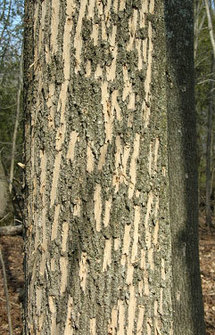 Watching for
Emerald Ash Borer (Agrilus planipennis) (with the help of woodpeckers) – This
is probably the best time of year to watch for signs of the invasive woodborer,
emerald ash borer (EAB). EAB is just
across our borders in New Hampshire and Massachusetts, and we expect to find it
in Maine soon. During the winter until
the trees start to leaf out in the spring, woodpeckers often find and feed on
overwintering EAB larvae, which are nice and fat and make good eating at this
time of year. As the birds feed, they
flick off the gray outer bark, and expose the light-blond inner bark, leaving a
distinctive signature (although not unique to woodpeckers feeding on EAB). It is primarily the smaller woodpeckers, like
the hairy and the downy, that feed on EAB; although even smaller birds like
nuthatches do as well. When you are out
and about, watch for signs of woodpecker feeding on ash and let us know if you
see any. If you can, take a picture of
any feeding you see on ash and pass it on to us.
Evidence of woodpecker feeding on ash (Photo:
Maine Forest Service).
|
Fir Coneworm (Dioryctria abietivorella) – A Christmas tree grower in northern
Aroostook County reported significant damage to balsam fir leaders in
plantation trees. Larvae were found
mining the terminal cluster of buds early in the season and later boring into
the terminal shoots. The grower
estimated that at least one in fifty trees in the plantation was damaged. Fir coneworm will infest the cones and shoots
of a wide-range of conifer species. A
bumper-crop of cones in surrounding forest trees in 2015 may have led to the
problem in the Christmas tree plantation this year. The grower mitigated damage with corrective
pruning when getting the trees ready for market. To aid in population reduction, pruning
before the caterpillars leave the shoots and destruction of the infested
material should accompany corrective pruning where possible.
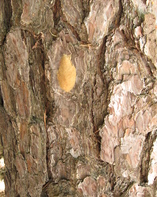
Gypsy Moth (Lymantria dispar) – Control of next
year’s gypsy moth populations on ornamental trees can begin now. You may still see stray moths until a hard
frost, but peak activity has passed. As
you conduct work around your home, take note of any the buff-colored egg
masses. You can scrape and soak the egg
masses or treat them with horticultural oil in place. If you are finding lots of egg masses (more
than you can count on your fingers) around your home let us know— photos, about
how many, in what size plot of land, and where—your information can help us
focus survey efforts to areas we might not otherwise visit. Please let us know
if you think you have found egg masses outside the gypsy moth quarantine area.
You can send this information to allison.m.kanoti@maine.gov or call (207) 827-1813.
Photo: Gypsy moth egg mass (Photo: Maine Forest Service).
|
Hemlock Woolly Adelgid (Adelges
tsugae) – Hemlock woolly adelgid (HWA) has now been confirmed in three towns
around Sebago Lake: Raymond, Frye Island, and Standish (Cumberland County). Winter is a good time of year to examine your
trees for HWA, as their growth of waxy ‘wool’ makes them more visible. Remember that winter is the safest time to
cut down and transport infested trees, because no mobile stages are
present. You will minimize the risk of
spreading HWA if you conduct your silvicultural practices on infested hemlock
before April.
 Tracking Winter Moth (Operophtera brumata) –
When you are
out in the woods this fall and winter keep an eye out for large numbers of
moths. If you are east of Rockland or in towns removed from the coast and
seeing numbers of moths we encourage you to collect and submit samples to the
lab (mailing address above). We know winter moth can be found along the
southern coast and would like to know if it has spread inland. Also we are
looking for the Bruce spanworm (Operophtera bruceata) outbreaks.
This insect is a native that is closely related to the invasive winter moth and
we would like to be able to study what keeps it under control.
Photo: Male winter moths rest around an outside light (Photo: Maine
Forest Service).
|

Armillaria Root Disease
A recent site visit to a wood
lot in Waterford brought to light a tree health issue linked to chronic tree
stress that is likely more common than many people realize: Armillaria root disease. Although the symptoms of this root disease can be obvious and severe, the signs of the fungal pathogens causing Armillaria root disease are often
cryptic and difficult to find and confirm.
During the Waterford site visit
crown dieback and mortality were observed among many of the hemlock trees in a
general area in close proximity to a river.
The symptoms of concern were occurring in a uniform pattern in the
crowns of the trees, with no visible signs of environmental, fungal or insect
attack to the needles, branches or main stem (with the exception of a few trees
that appeared to have been attacked by hemlock borer). This pattern of symptoms is typically
attributable to damage localized at the root collar zone or the underground
roots. Upon closer inspection of the
lower portions of several symptomatic hemlocks and removal of some bark from
the lower stem and root flares, extensive white fungal growth (mycelial fans)
was observed, consistent with Armillaria
root disease.
Photo: Hemlock trees showing whole crown symptoms, indicating a possible causal agent at the root zone (Photo: Maine Forest Service).
|
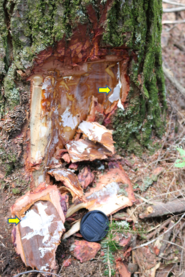 Species of Armillaria (commonly referred to as shoestring rot due to the flat
black strings of fungal tissue it produces under the bark of trees at its more
mature stages) can be readily found in the forest – the fungus is not only a
parasite, but is capable of living on dead wood as a decay fungus (saprophyte).
There are several closely related species of Armillaria that can cause disease in trees, but few are aggressive
enough to kill a tree on their own. Rather, mortality associated with Armillaria fungi is very commonly linked
to sources of chronic stress that weaken trees allowing Armillaria to become established. At Waterford, site history was
discussed with the landowner and it was mentioned that the site where the trees
were in poorest health had been frequently flooded over the past several years.
If the soil was inundated for an extended amount of time on several occasions
during the growing season, several years in a row, this certainly could
constitute a source of chronic stress that could very likely have made the
stressed trees susceptible to attack, decline and mortality from an Armillaria root disease pathogen. This highlights the importance of considering
longer term site history when assessing tree health problems. Although the year
the trees died (2016) was a very dry year at the site, repeated inundation of
the root zone over the past several years was likely the underlying factor
leading to Armillaria root disease
and mortality.
Photo: A sign of Armillaria root disease: white fans of fungal
tissue (mycelial fans) growing under the bark and parasitizing the tree (Photo:
Maine Forest Service).
|
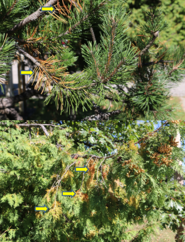 Natural Fall Needle Shedding
This time of year you may notice on most conifer species* that the
leaves/needles on twigs and branches furthest from the branch tips/buds (the
oldest needle age classes) are turning pale yellow to orange and may be
shedding onto the ground. Unless clear signs of injury or wilting are visible,
there is no cause for alarm. This is
very likely simply due to the natural phenomenon of seasonal leaf drop and not
an insect or disease problem. Although conifer needle disease pressure has been
high during the past few years (see ‘White Pine Health’ section) premature defoliation
from those disease agents typically happens in June and July.
Photo: Typical seasonal
needle drop by (top) mugo pine; (bottom) white cedar (Photo:
Maine Forest Service).
The theory behind
seasonal needle drop is that conifers shed older needles to ‘balance their
energy budget’, so to speak. The older
needles are shed because they represent a greater energy cost in terms of
maintenance than they generate through photosynthesis. The energy that the tree no longer has to
spend on maintenance of older, shed needles is instead invested in next
season’s new growth, which will be more photosythetically productive.
Seasonal needle drop can be expected to be more noticeable in Maine
this year, as more needle age classes are shed due to the droughty summer
conditions in the southern half of Maine.
Likewise, in northern areas that have experienced higher than normal
rainfall, needle drop may also be more noticeable, as high soil moisture, like
drought, is a source of stress that tends to increase seasonal shedding of
conifer needles.
*Deciduous conifers like larch species and dawn redwood will lose all
of their needles (leaves) in fall and refoliate each spring.
|
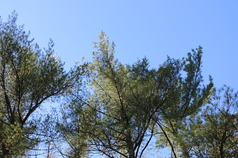 White Pine Health
Despite overall drier
weather conditions this year, the severity of white pine needle diseases was
still significant in many parts of Maine in 2016. Further, the impact of the several preceding years
of high needle disease severity is becoming increasingly visible as reduced
shoot growth, reduced diameter, an overall thin appearance of crowns, branch
dieback and in some cases mortality. This
type of chronic stress can be an inciting factor leading to a spiral of
decline. Damage from one or more agents
causes a greater susceptibility to other insect and disease agents that can
lead to further insect and disease issues, leading in this case to increased incidence
of mortality in the white pine resource. This situation is concerning and white
pine health will continue to be a focus in 2017.
Photo: An example of the thin appearance of white pine crowns resulting from the casting of 2nd- and 3rd-year blighted needles (Photo: Maine Forest Service).
Due to the long-term impacts on white pine
health seen in Maine and throughout New England, funding is currently being
sought from the US Forest Service to formally assess the present state of white
pine health, determine how trees are reacting to the stress, the impact on
white pine regeneration and what might be done to improve future conditions for
white pine in the region.
|
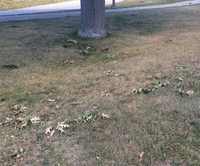 |
|
Squirrel Damage
– Oak branches about 8–18 inches long chewed off usually at an angle are the
work of squirrels after the acorns.
Photo:Branches broken off by squirrels (photo: Maine
Forest Service).
|
October
20th, 9-11, Spruce Budworm Outbreak in NB and Maine: Monitoring & Citizen
Science, Augusta. Join Rob Johns of
Natural Resources Canada to learn about biology, and economic impact of the
eastern spruce budworm, the mass migration event that occurred in New Brunswick
in July, and the application and safety of pesticide mechanisms for budworm
control. He will also cover the early intervention strategy being implemented
in New Brunswick including the Budworm Tracker initiative. Allison Kanoti of
the Maine Forest Service will provide an update on conditions and monitoring in
Maine. All are welcome but due to space constraints pre-registration is
required (http://sprucebudwormmaine.eventbrite.com, or call (207 581-3794).
October 22nd,
1-3 pm, Friends of Dr. Edith Marion
Patch, Page Farm and Home Museum
University of Maine, Orono. Everything
You Always Wanted to Know About Invasive Insects - But Were Afraid to Ask...
featuring Browntail Moth coming soon to a forest near YOU!
Join us to learn about the insects that are creeping, crawling, and winging
their way into Maine. How are they being monitored? How are they
affecting our environment? What role can we play in managing this
invasion? The presentation will be followed by refreshments.
October 26th, 6pm, Downeast
Lakes Land Trust History & Heritage Lecture, Grand Lake Stream School
Bldg. Aliens and Super Heroes of the Forest Insect
World. Celebrate Halloween early! Be prepared to be creeped out, frightened and amazed by the forest insect
world around us. Tales of body snatching, alien terrors for trees and the
superheroes of the forest await you.
This talk has been approved for 1 CEU for SAF CF and Maine Licensed
Foresters as well as Licensed Pesticide Applicators. Details on-line at: https://www.downeastlakes.org/news-events/events/
January 10-12th 2017, State
of Maine Agricultural Trades Show, Augusta, ME. Keep an eye on the developing program for
this annual event in Augusta. As the
date draws closer, you will find links to the program on our Department’s
homepage: http://www.maine.gov/dacf/index.shtml
under “Events”.
March
8-10, 2017, Northeastern Forest Pest
Council, Bangor, ME. The Northeastern Forest Pest Council’s 79th
annual meeting will be held in conjunction with the New England Society of
American Forester’s meeting at the Cross Insurance Center in Bangor, ME this
year. The agenda will include sessions
on emerald ash borer with a perspective from New Hampshire; forest tent
caterpillar, gypsy moth and spruce budworm—all of which caused notable
defoliation in the member-region in 2016; white pine issues including insects
and diseases; and range expansions of indigenous and exotic pests such as
southern pine beetle and balsam woolly adelgid. Those who have attended the meeting
in the past will recognize the Gerald N.
Lanier Graduate Student Session and the State and Province Updates. Information will be posted on-line: https://sites.google.com/site/northeasternforestpestcouncil/meetings.
Contents
Conditions Report No. 5, 2016
On-line: http://maine.gov/dacf/mfs/publications/condition_reports.html
Department of
Agriculture Conservation & Forestry
Maine Forest Service - Forest
Health and Monitoring
Contributors: Aaron Bergdahl, Charlene Donahue, Allison
Kanoti, Colleen Teerling
|